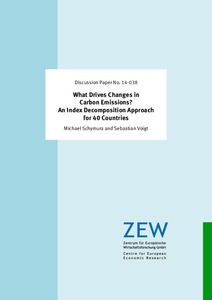What drives changes in carbon emissions? An index decomposition approach for 40 countries
"This study analyzes carbon emission trends and drivers in 40 major economies using the WIOD database, a harmonized and consistent dataset of input-output table time series accompanied by environmental satellite data. We use logarithmic mean Divisia index decomposition to (1) study trends in gl...
| Main Authors: | , |
|---|---|
| Institution: | ETUI-European Trade Union Institute |
| Format: | TEXT |
| Language: | English |
| Published: |
Mannheim
2014
ZEW |
| Subjects: | |
| Online Access: | https://www.labourline.org/KENTIKA-19118702124919369849-What-drives-changes-in-carbon-.htm |
| Summary: | "This study analyzes carbon emission trends and drivers in 40 major economies using the WIOD database, a harmonized and consistent dataset of input-output table time series accompanied by environmental satellite data. We use logarithmic mean Divisia index decomposition to (1) study trends in global carbon emissions between 1995 and 2009, (2) attribute changes in carbon emissions to either influences of economic activity, changes in technology, changes in the structure of the economy, alterations of the fuel mix, or changes in carbon intensities of specific fuel types, and (3) highlight sectoral and regional differences. We first find that heterogeneity in each country is higher than heterogeneity in sectors. This finding might lead to the conclusion that, in order to abate CO2, structural conditions in sectors prevail over regional circumstances. Regarding our results of the decomposition analysis, the drivers of changes in carbon emissions are very heterogeneous. Among the world’s top ten emitters, in only three countries – China, Germany and Canada – the main driver of an improved emissions performance was technological change. Conversely, in Japan and Australia structural change of the economy contributed to less severe increases of emissions. The deployment of cleaner energy sources had a positive in some, mainly developed, economies. Moreover, our results for the global level suggest a general move towards more ecient means of production." |
|---|---|
| Physical Description: | 19 p. Digital |

